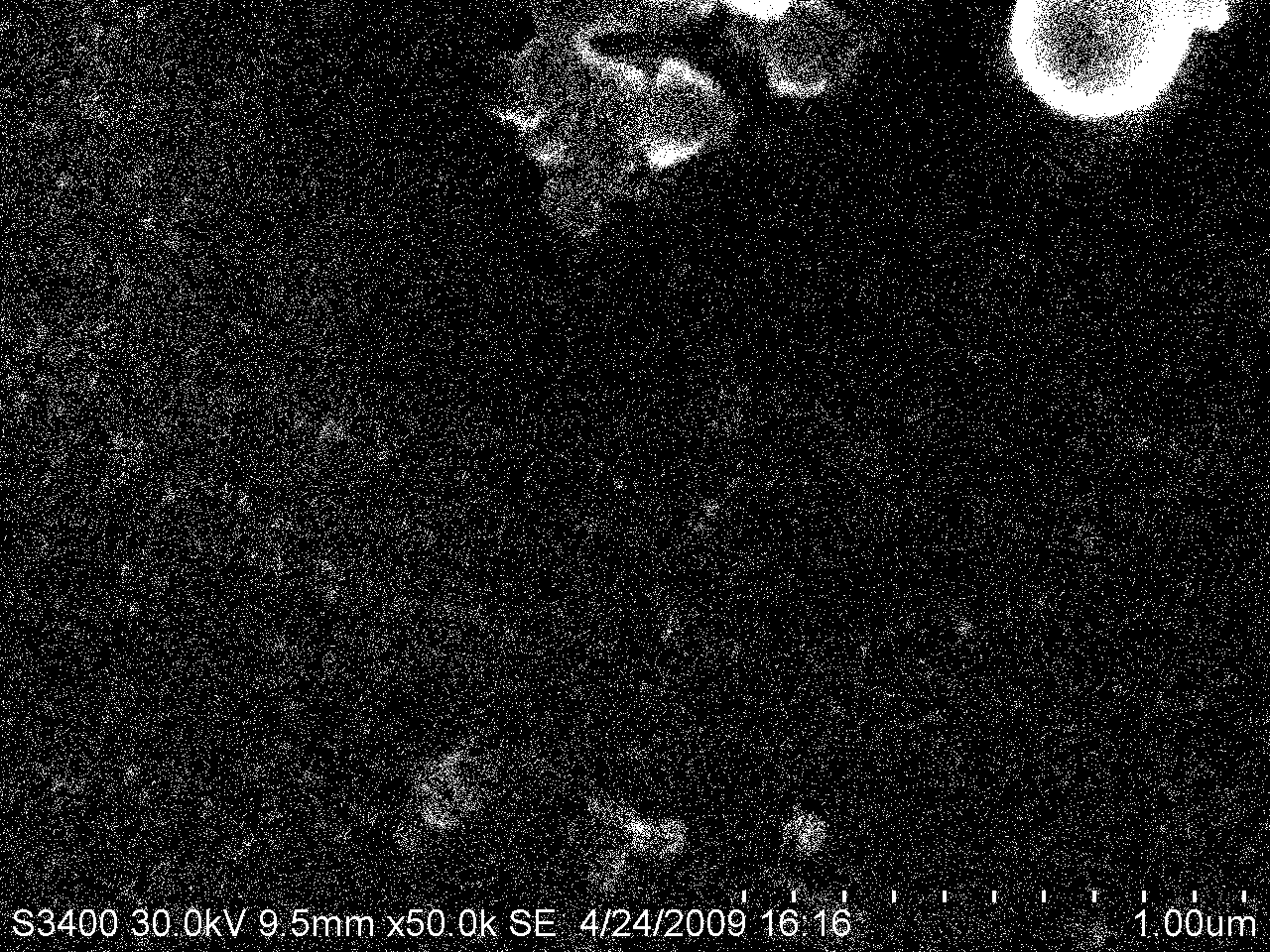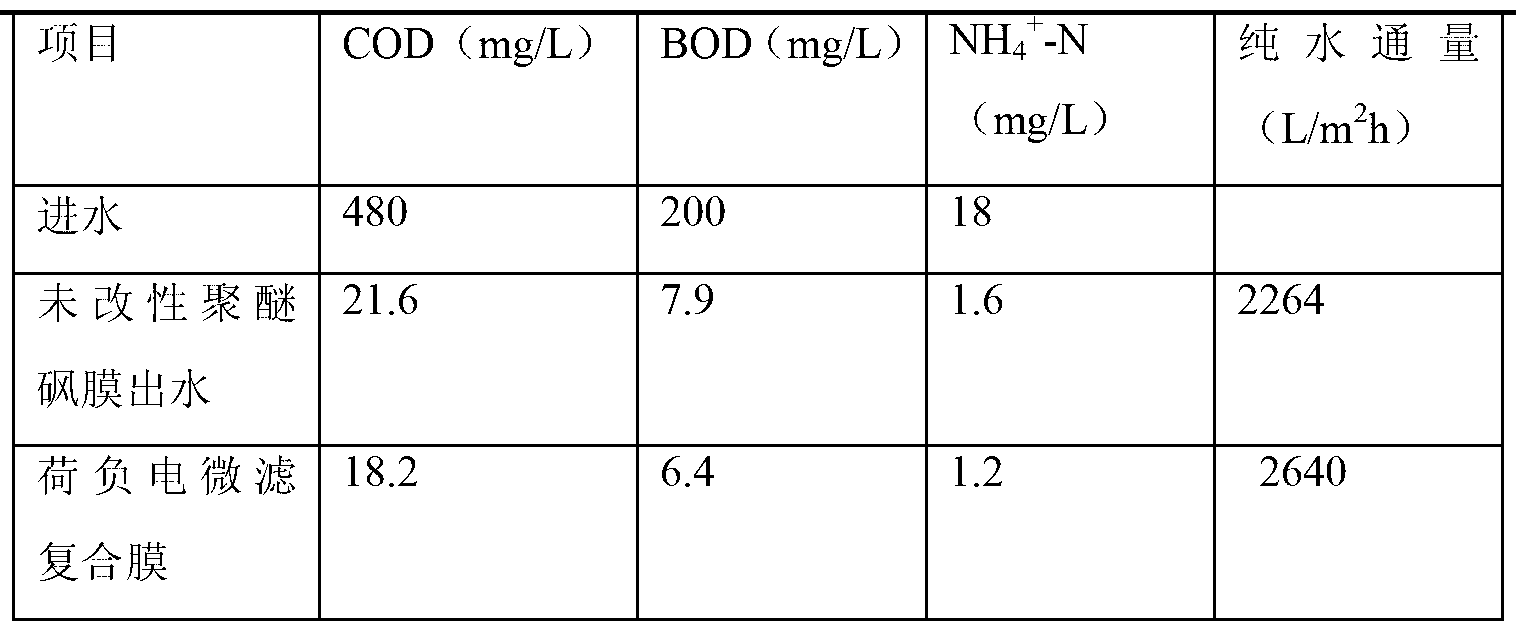Manufacturing method and application of electronegative composite microfiltration membrane
A manufacturing method and negatively charged technology, applied in chemical instruments and methods, ultrafiltration, membrane technology, etc., can solve the problems of small flux, small pore size, and inability to use membrane bioreactors, etc., and achieve narrow pore size distribution and porosity Moderate, strong anti-pollution effect
- Summary
- Abstract
- Description
- Claims
- Application Information
AI Technical Summary
Problems solved by technology
Method used
Image
Examples
Embodiment 1
[0028] A kind of manufacturing method of negatively charged microfiltration composite membrane provided by the present embodiment is carried out according to the following steps:
[0029] (1) Dissolve 12g of polyethersulfone in 73g of N,N-dimethylformamide organic solvent at 50°C, add 15g of polyvinylpyrrolidone organic additive, fully stir to dissolve, filter the insoluble matter and stand for defoaming to obtain Casting solution.
[0030] (2) Cast the casting solution onto the polyester non-woven fabric, control the gap between the scraper and the polyester non-woven fabric to be 100-200 μm, scrape the film with a scraper, let it stand in the air for 10-60 seconds, and then Under the temperature condition of 20-80°C, immerse in an organic solvent coagulation bath accounting for 0-1% of the total mass to form a film, then immerse the film in sodium polyacrylate solution for 30-60 minutes, take it out and dry it. The gap between the scraper and the polyester non-woven fabric ...
Embodiment 2
[0038] A kind of manufacturing method of negatively charged microfiltration composite membrane provided by the present embodiment is carried out according to the following steps:
[0039] (1) Dissolve 9g of polyethersulfone in 75g of N,N-dimethylformamide organic solvent at 50°C, add 16g of polyvinylpyrrolidone organic additive and 2g of polystyrene sodium sulfonate PSS solution, fully stir to dissolve, and filter The insoluble matter is left to stand for defoaming to obtain the casting solution.
[0040] (2) Cast the casting solution onto the polyester non-woven fabric, control the gap between the scraper and the polyester non-woven fabric to be 100-200 μm, scrape the film with a scraper, let it stand in the air for 10-60 seconds, and then Under the temperature condition of 20-80°C, immerse in an organic solvent coagulation bath accounting for 0.5% of the total mass to form a film, then immerse the film in polystyrene sodium sulfonate PSS solution for 30-60 minutes, take it o...
Embodiment 3
[0044] A kind of manufacturing method of negatively charged microfiltration composite membrane provided by the present embodiment is carried out according to the following steps:
[0045] (1) Dissolve 8g of polyethersulfone in 60g of N,N-dimethylformamide organic solvent at 50°C, add 18g of polyvinylpyrrolidone organic additive and 14g of sodium carboxymethyl cellulose solution, stir well to dissolve, filter insoluble The material was left to stand for defoaming to obtain the casting solution.
[0046] (2) Cast the casting solution onto the polyester non-woven fabric, control the gap between the scraper and the polyester non-woven fabric to be 180 μm, scrape the film with a scraper, and let it stand in the air for 60 seconds, then at a temperature of 25°C Under certain conditions, immerse in an organic solvent dimethylformamide coagulation bath accounting for 0.2% of the total mass to form a film, then soak the film in sodium carboxymethylcellulose solution for 60 minutes, tak...
PUM
| Property | Measurement | Unit |
|---|---|---|
| thickness | aaaaa | aaaaa |
| pore size | aaaaa | aaaaa |
| pore size | aaaaa | aaaaa |
Abstract
Description
Claims
Application Information
 Login to View More
Login to View More - R&D
- Intellectual Property
- Life Sciences
- Materials
- Tech Scout
- Unparalleled Data Quality
- Higher Quality Content
- 60% Fewer Hallucinations
Browse by: Latest US Patents, China's latest patents, Technical Efficacy Thesaurus, Application Domain, Technology Topic, Popular Technical Reports.
© 2025 PatSnap. All rights reserved.Legal|Privacy policy|Modern Slavery Act Transparency Statement|Sitemap|About US| Contact US: help@patsnap.com



